Keiichi Tanaami is a painter who started his career as a successful graphic designer/art director. Now, he is in mid-70s, but still his creation is developing and all of his works are really energetic. His unique colors and motifs were brought from his life experiences including the war and a serious illness. Although it sounds tragic to us, Tanaami got through those difficult circumstances by finding a source of pleasure in art. He’d drawn anything attracted him and they became all of his important motifs.
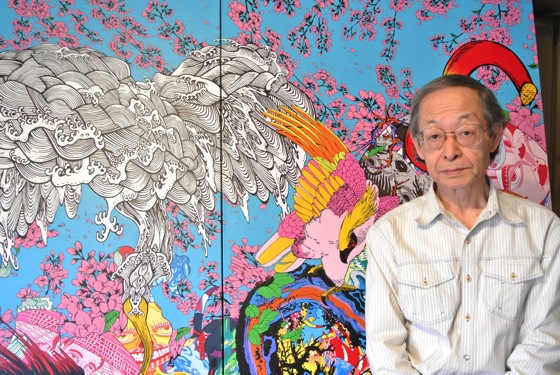
Keiichi Tanaami in front of his painting.
Pleasure under the hard circumstances
- You use some of the same unique motifs repeatedly. How were they born?
All my motifs came from what I encountered in my life. For example, the pine tree was what I saw when I was diagnosed with tuberculosis (at the age of 44). I got a high fever and hallucinations every night after I was injected. I had to be in the hospital for 4 months. One day, when I saw pine trees from a window at night it looked like this, I mean, it looked twisting and turning because of my hallucinations. Since I had plenty of time, I drew the pine tree that I had seen the night before. This is how this pine tree motif was born.
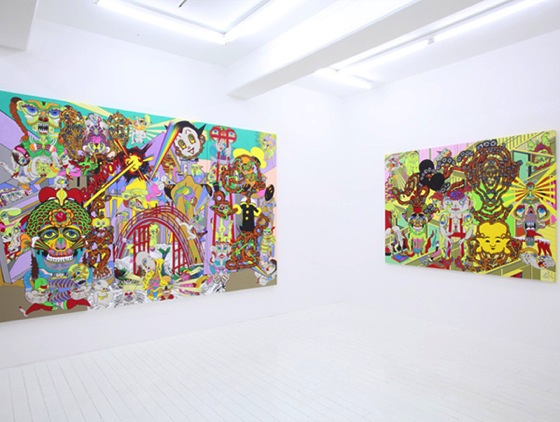
Keiichi Tanaami “Dividing Bridge” at NANZUKA gallery, 2011
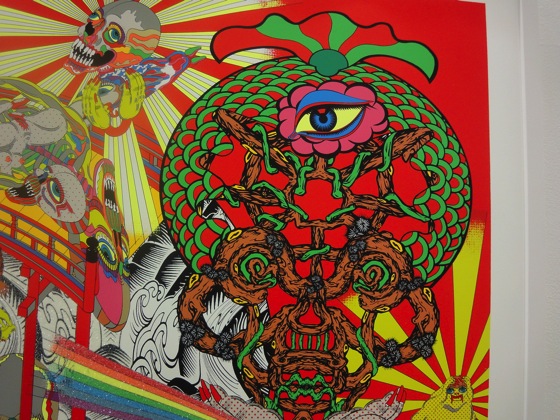
Detail of “Lost and Wandering Bridge Series 4“. The pine tree and gold fish motifs are combined to create a skull.
-Many of your motifs are related to your tragic experiences. Although, there is no sorrow or sadness in your work. It is more strong and energetic. Do those motifs recall your difficult times?
I was quite little (9 years old) during the war. It was a hard time – there was no food, nothing to see. And there were air attacks everyday. I think I wasn’t afraid since I was too little. However, I could understand that things weren’t normal by seeing my mother’s behavior. I sensed the situation by seeing adults around me but not directly from the war itself. I didn’t feel impending fear of dying by a bomb.
-So the goldfish motif is not really connected with the fear of war but more with its aesthetic.
Right. I was in a bomb shelter and had nothing to do. We went into the shelter everyday at dawn, which is just a cave since air attacks came every night. We just had to stay in there quietly. For a kid, it was really boring. Then, when the bombs fell nearby, its heat was hot as if your face is burning. My mother kept putting a wet towel on me to relieve the heat. There was water in the cave up to my knee. I was very tired, but I couldn’t sleep. In that situation, just seeing goldfish swimming in a tank was a real pleasure for me.
Flare bombs fell down and their lights were reflected on the goldfish’s scales. It was like watching a movie and it was quite fun. So it is not related to my tragic memory but more to a delightful moment.
And I think, under that kind of tragic situation, people can’t get through it if one cannot find something enjoyable. I think human beings are well-created to behave like that so that they can escape from those mental horrors.
-Do you see the pine tree motif as the same delightful moment?
Yes. When I was sick, my temperature got lower in the morning as the medicine became less effective. I felt good and enjoyed drawing the pine trees that I saw the night before. I had to take the medicine at night again and I repeated this over and over. It was hard but I endured it by drawing a lot.
I encountered many interesting shapes and colors at these important points in my life. Each of them became one of my motifs.
-Why do you use the same motifs repeatedly?
It may look I am using the exact same motifs but even when I use the same skull motif, I change its shape by widening it or reshaping it. I’m trying not to draw it in the same way.
I am not using my motifs as a character. How I change it will be determined by the theme of the work.
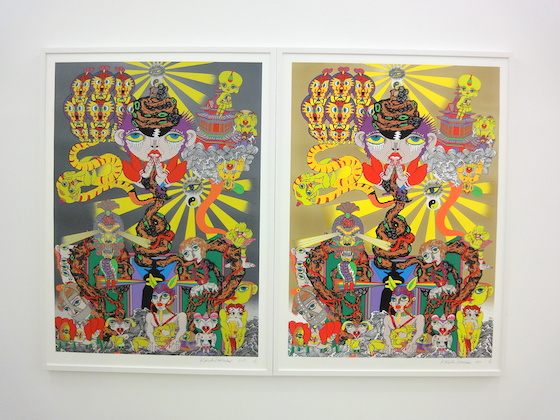
Keiichi Tanaami “Lost and Wandering Bridge Series 2” and “Lost and Wandering Bridge Series 3” exhibited.
Red ground and blue sky divided by the horizon is my starting point
-How do you put your ideas into work?
Usually painters start with shapes and add colors afterwards, but I start with colors. Blue here, red here and yellow there… I imagine the allocation of colors in my mind, then I think of shapes. So the painting is completed in my mind first.
-How long does it take to decide the composition?
I don’t take 2 or 3 days to come up with ideas. It’s just in a second. I don’t change it afterwards. Usually, the first idea is the best. It gets worse when I rethink it.
I use a color chart book to instruct my assistants of the colors. There are about 1000 colors in it but I usually use the same colors. Colors show many expressions depending on their combinations. I use similar bright coloration in all of my works but the amount and combination are different.

Keiichi Tanaami’s drawings at “Dividing Bridge”, 2011
-Where did your iconic colors come from? Is it from your childhood?
The movies that I saw when I was little were in black and white. Mickey Mouse was in monochrome too. In a sense, I had a strong desire for colors and was longing for it. Since I already had interest in art at that time, I imagined how the movie will look like in color all the time. For example, I stayed in a theater for the entire day and drew Mickey Mouse by seeing the same movie for many times. Because of that, I could draw it perfectly. Then, I went back to my house and drew Mickey Mouse in colors. I really enjoyed doing it.
There was no color seen anywhere. It was not only in the movies. Not even in the city. No neon lights. No television. No picture books. That is why I had a strong desire, or I hoped to see colors. I think this experience affected my coloration later in my life.
Even when you see the monochrome movies nowadays, it looks like a colored movie. I mean, you color the scenes in your brain. However, back then, when I saw a Hollywood movie, we didn’t know what foreign people looked like, so the color didn’t come up in our minds. For example, it was hard to imagine the color of foods which foreign actors were eating in a movie. Now, we know that. But back then, we couldn’t imagine the color of New York City.
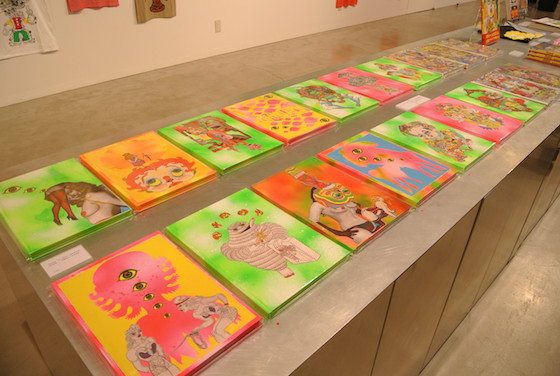
Special editions of Keiichi Tanaami’s book “Killer Joe” placed at exhibition “Tanaami Tee x 100″, 2013. Silkscreen printed on the face of book.
-Then, what was your first exposure to color in your childhood?
I’ve talked about this story quite often but the house next to my place was a beautiful Western style house. It was quite rare in that time. There were no other people living in a Western style house. The man who was living in that house was named Mr. Kai who was renown conductor in Germany after WWII. He was a college student and he often invited me as a little kid to his house. In that very poor era of Japan, that family was drinking tea with cake. I hadn’t seen a tea cup or had a piece of cake before. I was really surprised about that.
-What was your family’s business? Did you gain any influence from it?
My family was a wholesaler of fabric for clothes, fabric for business suits. It was located at the back of Nihon-bashi Takashima-ya department store (classical department store open since 1831, Tokyo). Back then, there were many fabric wholesalers at that area.
-Business suit doesn’t sound colorful though.
No, they weren’t colorful. However, the only thing that I liked was the merchandise mark inside the suit. Recent marks are just a little tag but when I was little, they placed a large emblem inside the suit. It was made with embroidery threads and very beautiful. That emblem was something to show your status and brand. Those large emblems came in a long roll. We cut one tag and placed it inside a business suit. There were lots of emblem rolls in our storage and I liked it the most. Their shapes and colors were beautiful. I played with them rolling it on clothes.
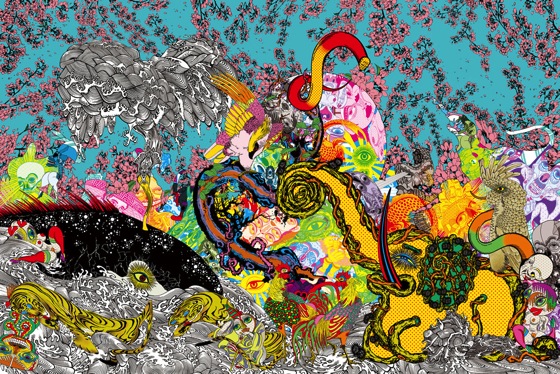
Keiichi Tanaami “タイトル(確認)” inspired by Jyakuchu Ito’s “A whale and an elephant”

Keiichi Tanaami “Kochuten” 2009 at NANZUKA gallery.
-The red you use is really unique. Does your color come from a specific object?
Colors aren’t connected with a unique object. However, the most impressive color experience in my life is this. When the war was over, I came back from Muika-machi, Niigata where I evacuated with my mother, to Meguro (Tokyo). There was a hill on the top of Gon-nosuke-zaka sloping road. The last memory of my hometown (Meguro) had been filled with greens and buildings. And the landscape seen from the hill had been beautiful. However, what I saw when I returned upon the hill, was nothing. No houses, no trees, no green at all. There was only red scorched earth spread toward the horizon. It was red-brownish ground. Up above the horizon was deep blue sky. Since there were no cars or smog, the sky was truly a bright blue sky, almost like a painting. No clouds were in the sky. Only two colors, red ground and blue sky.
There was a shock of loss because just in a few years after I left the city, nothing was left. Moreover, I was astonished by the 2 color divided landscape – red and blue. I had many color experiences after that but there is nothing goes beyond that experience.
Whenever I start to think of a work, 2 divided screens with red ground and blue sky come up to my mind naturally. Then I start to place many colors and motifs into that screen.
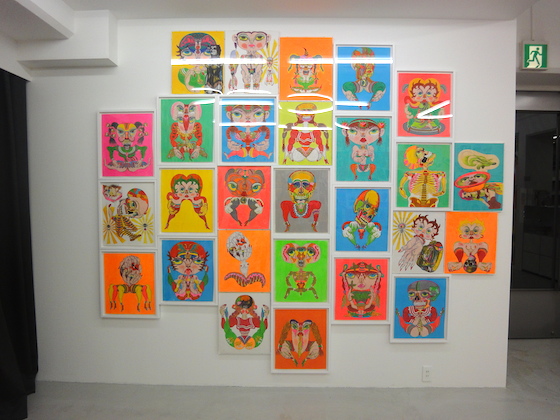
Keiichi Tanaami’s drawings exhibited at “New animation & Drawings” at NANZUKA gallery, 2012
-How about the drawings?
I do many kinds of projects and need to relieve my stress. I don’t do anything beside art. I don’t do sport, travel or play golf. I drink a little but my hobby and work are both art. I relieve my stress by drawing. I do drawings without any deep thoughts. For me, it is like a sport in terms of moving with body and releasing my energy out.
I placed two works together in my recent works (below). I gathered two drawings from different years. For example, works drawn in 1980 and in 2013 are put next each other. There is a time discrepancy between the two and my expression style has changed in some of them. It is interesting.

Keiichi Tanaami’s drawings exhibited at “New animation & Drawings” at NANZUKA gallery, 2012
-Why did you start to combine two drawings?
I used to play with wood blocks in my childhood. And I recalled that memory a while ago. Memory is interesting. When you recall one of them, the other related memories will be pulled out too. When I recalled my wood blocks, the scenes of my room came out.
When I recalled my mother’s kimono pattern, I recalled the situation at that moment. I found that interesting. When you recall one memory then it brings up other related memories like a chain reaction. So I combined two drawings.
I don’t draw about the future but the fragments of my past memory. When I first drew the wood blocks in my childhood, it brought up many images.
-Does your memory come out automatically? rather than trying to recall it?
I don’t try to recall my memory.
Since I went through the war which is rare, memory of my childhood strongly remains in my brain. I think so. Because it was such a big shock, it will never be erased. I think it is stronger than other memories. I don’t remember about my art college days. I couldn’t recall my memory about it. However, I can recall the movie what I saw in my childhood

Collaged works by Keiichi Tanaami at “KILLER JOE’S (1965 – 1975)” at NANZUKA gallery 2013.
-Can you tell us about your collaged works (above)?
They were created to provide images for the publishers. I kept them and 80% of them were not exhibited until now. Back then, the works that I provided to the publisher were discard so many of them were gone.
Even in my recent paintings, you can see it as a composition of collaged motifs. The method has changed from cutting and pasting with paper to digital computer.
-Had you seen your collaged works created 40 years ago?
No, I keep my work in several storages and these works were kept unopened for quite a long time. However, recently I got offers from abroad to show my works from the 60s and 70s and that is the main reason that I pulled them out.

Drawings by Keiichi Tanaami at “KILLER JOE’S (1965 – 1975)” at NANZUKA gallery 2013.
-How do you collect images?
I get a lot of influence from movies or novels and they are all input into my brain. And they come out naturally, united in one image. And that is how my work appears. I don’t stock motifs intentionally in my daily life.
-How do you set up a theme or get inspirations in your life?
Rather than getting inspiration directly from the movies, or Leonald da Vinci’s paintings for example, I get inspiration from an article in a newspaper, one scene in a comic, a photo of a murder’s execution or a sportsman in sports section.
Images come out naturally. I don’t try to pull them out. There is a theme that I set by myself and they come into being naturally.
-Thank you.

Keiichi Tanaami’s desk at his studio.
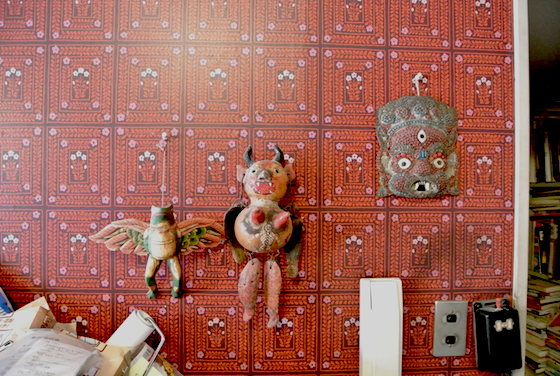
Funny objects hung on Tanaami’s studio. Their decorations are similar to Tanaami’s works, aren’t they?
Interviewed on May 7th, 2013 by Rasa Tsuda.


